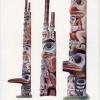Haida totem pole known as Star House Pole (3-D)
Commentary
The totem pole in the Pitt Rivers Museum is from the Haida Nation, people who occupy a group of islands off the coast of northern British Columbia, Canada. This house frontal pole came from Star House in the village of Old Massett. It was raised by Chief Anetlas at a potlatch before July 1879 when he and his wife, until then childless, adopted a young girl. The figures on the pole show the histories, ancestral crests, social status and privileges of the family whose house it marked. Anetlas died about 1893. The pole was removed from Star House in 1901 and has been in the Pitt Rivers Museum since then.
Carver(s): Albert Edward Edenshaw and/or Charles Edenshaw
Date of carving: before July 1879
Continent: North America
Geographical area: North America
Country: Canada
Region/Pace: British Columbia; Haida Gwaii (Queen Charlotte Islands); Masset
Cultural group: Haida
Size: 11.36 m (height)
Acquisition: Edward Burnett Tylor. Donated 1901
***
Object description: ‘House pole carved with raven at the base, bear, human, bird and frog figures. This house pole was commissioned by Aniithlaas, or Aniitl’aas, to mark the adoption of a daughter. The pole contains figures from his lineage, his wife’s lineage and figures that likely help to tell the Bear Mother story. At the base of the pole is a large raven figure with black and blue wings on either side, and a large black beak accented with red that protrudes outward from the pole. The beak is carved separately from the pole and is now held in place by a metal support, also painted red, in addition to any internal fixings. The area around the eyes is painted blue and the eyes and eyebrows are large and painted black. Under the beak of the raven, and in front of the body, is a human figure with a blue face with black accents. In front of the human’s stomach is a red figure facing downward that is likely a sea-bird, and possibly a grebe. Above the raven are two small bear cubs that cover the feet of a human. The human’s knees are bent and protrude out from the pole. The human is grasped in the paws of a large bear figure. The human’s knees are bent and protrude out from the pole. The human is grasped in the paws of a large bear figure. The human’s arms are bent and its hands are on the arms of the bear. The mouth of the human is slightly open showing teeth. The area around the eyes is painted in blue and the eyes and eyebrows are again painted black. The head of the human sits in front of the mouth of the bear. The mouth of the bear shows two rows of teeth and pronounced canines. The snout of the bear is large, rounded and red. The area around the eyes, the eyes themselves and the eyebrows have the same blue and black treatment as the other figures. Between the ears of the bear is a downward-facing bear cub. The back of the cub is visible, as are its face and appendages. The painting on the back seems mottled, to indicate fur. Above the cub is a frog, also facing downwards, but being eaten by a bear near the top of the pole. The frog is painted light blue. The front half of its body and front legs are most clearly visible, though two small portions of its rear feet or legs are also visible in either corner of the bear’s mouth. The bear is grasping the frog’s body in its front paws. The hind legs of the bear are located on either side of the pole and are bent. No teeth are visible in the bear’s mounth. It has the same blue and black treatment on the face around the eyes. On top of the bear’s head are three human figures called ‘Watchmen’. They are sitting with their knees bent upwards and hands clasped around their knees. There is one Watchman facing forward in the centre of the pole, and one on either side. The ones on the sides have their legs and hands coming through the outline of the bear’s ears. The bodies of the Watchmen are painted red, and their faces are painted white with red and black accents. They each wear a tall hat with black and red rings. The central figure has one additional ring on his hat than the two on the sides. The reverse of the pole is flat and the heartwood has been removed.’ (Description by Cara Krmpotich.)
An introduction and overview of recent findings on Star House Pole has been published in a new museum booklet: Laura Peers with contributions by Jisgang (Nika Collison), Philip Grover, Cara Krmpotich and Christian White, Star House Pole (Oxford: Pitt Rivers Museum, 2018), ISBN 978-0-902793-57-6. The booklet can be freely accessed and read online via the web link on the right (‘Star House Pole’) or here. Printed copies of the booklet can be ordered via the Ashmolean Online Shop here https://shop.ashmolean.org/star-house-totem-pole.html.

